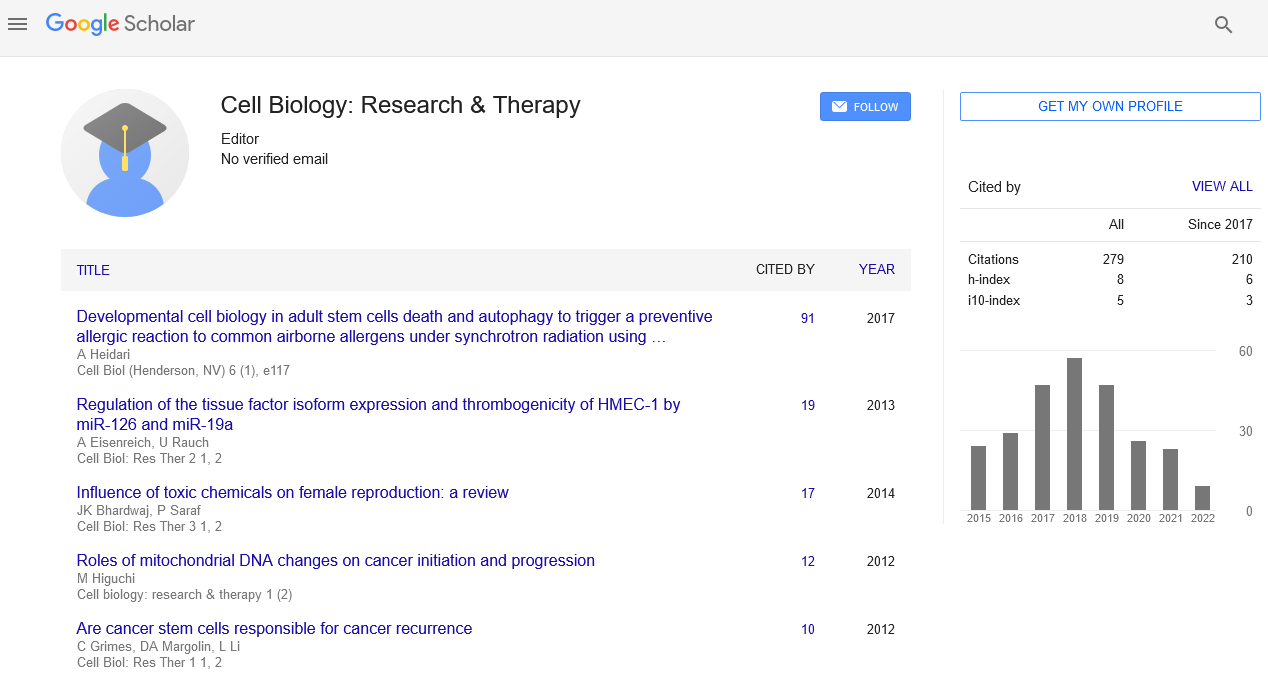Commentary, Cell Biol Vol: 12 Issue: 2
Collective Cell Migration and the Coordination of Cell Movements within a Group
Zhidan Wang*
1Department of Cell Biology, Peking University, Beijing, China
*Corresponding Author: Zhidan Wang,
Department of Cell Biology, Peking
University, Beijing, China
E-mail: wang@zhidan.cn
Received date: 24 May, 2023, Manuscript No. CBRT-23-104964;
Editor assigned date: 26 May, 2023, PreQC No. CBRT-23-104964 (PQ);
Reviewed date: 09 June, 2023, QC No. CBRT-23-104964;
Revised date: 16 June, 2023, Manuscript No. CBRT-23-104964 (R);
Published date: 23 June, 2023 DOI: 10.4172/2324-9293.1000175
Citation: Wang Z (2023) Collective Cell Migration and the Coordination of Cell Movements within a Group. Cell Biol 12:2.
Description
Cell migration is a fundamental process in various biological phenomena, including embryonic development, wound healing, and cancer metastasis. While individual cell migration is well-studied, collective cell migration, where groups of cells move together in a coordinated manner, is a fascinating area of research. This study explores the concept of collective cell migration, its significance, mechanisms, and the coordination of cell movements within a group.
Collective cell migration
Collective cell migration refers to the movement of groups of cells, which can include cell sheets, clusters, or strands, in a coordinated manner. Unlike individual cell migration, where a single cell navigates through its environment, collective migration involves interactions and coordination among neighbouring cells.
Significance of collective cell migration
Collective cell migration plays crucial roles in various biological processes include
Embryonic development: During embryogenesis, collective migration is vital for shaping tissues and organs. Cell collectives migrate to specific locations, contributing to the formation of structures like the neural tube, heart, and limb buds.
Wound healing: In the process of wound healing, collective migration allows epithelial cells to close the wound efficiently. Collective migration helps maintain tissue integrity and restores the barrier function of the epithelium.
Cancer metastasis: In cancer, collective cell migration is involved in the dissemination of tumor cells from the primary site to distant organs. Clusters of cancer cells migrate collectively, aiding their survival and enhancing their ability to invade and colonize new sites.
Mechanisms
Several mechanisms drive the coordination of cell movements within a group are as follows
Cell-Cell adhesion: Cell adhesion molecules, such as cadherins and integrins, mediate physical connections between neighbouring cells. These adhesive interactions enable the transmission of mechanical forces, facilitating coordinated movement within the cell collective.
Cell-Cell communication: Cells within a migrating group communicate through various signalling pathways. For example, chemical signals, including growth factors and cytokines, can guide cells towards a common direction, ensuring coordinated migration.
Leader-Follower model: In collective cell migration, some cells act as leaders, guiding the movement of the entire group. These leader cells exhibit distinct characteristics, such as increased protrusive activity and enhanced responsiveness to guidance cues, while follower cells align their movements with the leaders.
Mechanical forces: Physical forces, generated by contractile elements within cells, contribute to collective migration. Tension and contractility allow cells to exert forces on their surroundings, facilitating tissue remodelling and directional movement.
Coordination of cell movements within a group
Achieving coordinated cell movements within a group involves various processes are
Polarity and orientation: Cells within a collective establish polarity, with distinct front and rear ends. This polarity is crucial for directional migration. Cells align their polarity based on cues from the microenvironment, neighbouring cells, and guidance signals.
Leader-Follower dynamics: Leader cells at the forefront of the collective provide directional guidance, establishing the migration path. Follower cells respond to the cues from the leaders, adjusting their movements to maintain the integrity and cohesion of the group.
Mechanical coupling: Cells within a migrating group physically interact with each other. These mechanical couplings allow forces to be transmitted across the cell collective, enabling coordinated movements.
Chemical signalling: Cells communicate through chemical signals, such as diffusible factors and cell-surface receptors. These signals guide the group's migration by providing directional cues and coordinating cell behaviours.
Extracellular Matrix (ECM) Interactions: The ECM, a network of proteins surrounding cells, influences collective cell migration. Cells interact with the ECM through adhesion molecules, such as integrins, which transmit signals that regulate migration speed, direction, and collective behaviour.
Conclusion
Collective cell migration is a complex process that involves the coordination of cell movements within a group. Understanding the mechanisms and coordination involved in collective migration is crucial for deciphering developmental processes, wound healing, and disease progression. Future research in this field will focus on the intricate interplay of cellular and molecular events that drive collective cell migration, opening new avenues for therapeutic interventions in wound healing, tissue regeneration, and cancer metastasis.
 Spanish
Spanish  Chinese
Chinese  Russian
Russian  German
German  French
French  Japanese
Japanese  Portuguese
Portuguese  Hindi
Hindi 